Projected Heat Waves in Ecuador under Climate Change: Insights from HadGEM-RegCM4 Coupled Model
Abstract
1. Introduction
2. Materials and Methods
2.1. Region of Study
2.2. Data
2.3. High Temperature Anomaly Method
- Temperature anomalies are calculated by removing the average annual cycle for each grid point. For leap years, the mean Tmax on February 28th and 29th is considered.
- The 90th percentile (P90) is calculated for each day of the year and for each grid point within the regions. Only anomalous values above this threshold are considered for further analysis.
2.4. Heat Waves in the Coastal, Highlands, and Amazon Regions
- For each region, a time series is derived by calculating the mean of daily Tmax anomalies across all grid points within the region.
- The 90th percentile (P90) of anomalies for each time series is computed to serve as the threshold for defining heat waves:where is the intensity of the heat wave, represents the daily anomaly, and n is the number of consecutive days during the heat wave event.
- For the determination of heat wave events, we define the duration as the number of consecutive days during which exceeds the 90th percentile threshold (P90) [30], calculated for each calendar day from the baseline period of 1975–2005. The threshold is determined using a five-day running window centered on each calendar day.
2.5. Climate Drivers and Future Projections
3. Results
3.1. Maximum Temperature Climatology
3.2. Projected Climate Changes
3.3. Heatwave Analysis
4. Discussion
Adaptation Strategies and Policy Implications
5. Conclusions
Author Contributions
Funding
Institutional Review Board Statement
Informed Consent Statement
Data Availability Statement
Acknowledgments
Conflicts of Interest
Abbreviations
| GCMs | General Circulation Models |
| HadGEM2 | Hadley Centre Global Environment Model version 2 |
| RCPs | Representative Concentration Pathways |
| CMIP5 | Coupled Model Intercomparison Project Phase 5 |
| CMIP6 | Coupled Model Intercomparison Project Phase 6 |
| CO | Coastal |
| HL | Highlands |
| AM | Amazon |
| ITCZ | Intertropical Convergence Zone |
| Maximum Temperature | |
| ENSO | El Niño Southern Oscillation |
| ONI | Oceanic Niño Index |
| TX90p | Temperature exceeded on 90th percentile days |
| HWFI | Heatwave Frequency Index |
| PDO | Pacific Decadal Oscillation |
| SSP1-2.6 | Shared Socioeconomic Pathway 1 (Sustainability) |
References
- Robinson, P.J. On the definition of a heat wave. J. Appl. Meteorol. Climatol. 2001, 40, 762–775. [Google Scholar] [CrossRef]
- McGregor, G.R.; Bessmoulin, P.; Ebi, K.; Menne, B. Heatwaves and Health: Guidance on Warning-System Development; World Meteorological Organization: Geneva, Switzerland, 2015. [Google Scholar]
- Perkins, S.; Alexander, L.; Nairn, J. Increasing frequency, intensity and duration of observed global heatwaves and warm spells. Geophys. Res. Lett. 2012, 39, L20714. [Google Scholar] [CrossRef]
- Perkins-Kirkpatrick, S.; Lewis, S. Increasing trends in regional heatwaves. Nat. Commun. 2020, 11, 3357. [Google Scholar] [CrossRef] [PubMed]
- Feron, S.; Cordero, R.R.; Damiani, A.; Llanillo, P.J.; Jorquera, J.; Sepulveda, E.; Asencio, V.; Laroze, D.; Labbe, F.; Carrasco, J.; et al. Observations and Projections of Heat Waves in South America. Sci. Rep. 2019, 9, 8173. [Google Scholar] [CrossRef] [PubMed]
- Lopez, G.; Gaiser, T.; Ewert, F.; Srivastava, A. Effects of recent climate change on maize yield in Southwest Ecuador. Atmosphere 2021, 12, 299. [Google Scholar] [CrossRef]
- Gutierrez, H.; Lee, G.O.; Corozo Angulo, B.; Dimka, J.; Eisenberg, J.N.; Trostle, J.A.; Hardin, R. Perceptions of local vulnerability and the relative importance of climate change in rural Ecuador. Hum. Ecol. 2020, 48, 383–395. [Google Scholar] [CrossRef]
- Portalanza, D.; Horgan, F.G.; Pohlmann, V.; Vianna Cuadra, S.; Torres-Ulloa, M.; Alava, E.; Ferraz, S.; Durigon, A. Potential impact of future climates on rice production in Ecuador determined using kobayashi’s ‘very simple model’. Agriculture 2022, 12, 1828. [Google Scholar] [CrossRef]
- Sharifi, A. Resilience of urban social-ecological-technological systems (SETS): A review. Sustain. Cities Soc. 2023, 99, 104910. [Google Scholar] [CrossRef]
- Ceccherini, G.; Russo, S.; Ameztoy, I.; Romero, C.P.; Carmona-Moreno, C. Magnitude and frequency of heat and cold waves in recent decades: The case of South America. Nat. Hazards Earth Syst. Sci. 2016, 16, 821–831. [Google Scholar] [CrossRef]
- Coppola, E.; Raffaele, F.; Giorgi, F.; Giuliani, G.; Xuejie, G.; Ciarlo, J.M.; Sines, T.R.; Torres-Alavez, J.A.; Das, S.; di Sante, F.; et al. Climate hazard indices projections based on CORDEX-CORE, CMIP5 and CMIP6 ensemble. Clim. Dyn. 2021, 57, 1293–1383. [Google Scholar] [CrossRef]
- Reboita, M.; Fernandez, J.; Pereira Llopart, M.; Porfirio da Rocha, R.; Albertani Pampuch, L.; Cruz, F. Assessment of RegCM4.3 over the CORDEX South America domain: Sensitivity analysis for physical parameterization schemes. Clim. Res. 2014, 60, 215–234. [Google Scholar] [CrossRef]
- Teodoro, T.A.; Reboita, M.S.; Llopart, M.; da Rocha, R.P.; Ashfaq, M. Climate Change Impacts on the South American Monsoon System and Its Surface–Atmosphere Processes Through RegCM4 CORDEX-CORE Projections. Earth Syst. Environ. 2021, 5, 825–847. [Google Scholar] [CrossRef]
- Geirinhas, J.L.; Russo, A.; Libonati, R.; Sousa, P.M.; Miralles, D.G.; Trigo, R.M. Recent increasing frequency of compound summer drought and heatwaves in Southeast Brazil. Environ. Res. Lett. 2021, 16, 034036. [Google Scholar] [CrossRef]
- Pappalardo, S.E.; Zanetti, C.; Todeschi, V. Mapping urban heat islands and heat-related risk during heat waves from a climate justice perspective: A case study in the municipality of Padua (Italy) for inclusive adaptation policies. Landsc. Urban Plan. 2023, 238, 104831. [Google Scholar] [CrossRef]
- Khan, N.; Shahid, S.; Ahmed, K.; Wang, X.; Ali, R.; Ismail, T.; Nawaz, N. Selection of GCMs for the projection of spatial distribution of heat waves in Pakistan. Atmos. Res. 2020, 233, 104688. [Google Scholar] [CrossRef]
- Khan, N.; Shahid, S.; Ismail, T.B.; Behlil, F. Prediction of heat waves over Pakistan using support vector machine algorithm in the context of climate change. Stoch. Environ. Res. Risk Assess. 2021, 35, 1335–1353. [Google Scholar] [CrossRef]
- Demortier, A.; Bozkurt, D.; Jacques-Coper, M. Identifying key driving mechanisms of heat waves in central Chile. Clim. Dyn. 2021, 57, 2415–2432. [Google Scholar] [CrossRef]
- Bellouin, N.; Collins, W.J.; Culverwell, I.D.; Halloran, P.R.; Hardiman, S.C.; Hinton, T.J.; Jones, C.D.; McDonald, R.E.; McLaren, A.J.; O’Connor, F.M.; et al. The HadGEM2 family of Met Office Unified Model climate configurations. Geosci. Model Dev. 2011, 4, 723–757. [Google Scholar] [CrossRef]
- Giorgi, F.; Coppola, E.; Solmon, F.; Mariotti, L.; Sylla, M.; Bi, X.; Elguindi, N.; Diro, G.; Nair, V.; Giuliani, G.; et al. RegCM4: Model description and preliminary tests over multiple CORDEX domains. Clim. Res. 2012, 52, 7–29. [Google Scholar] [CrossRef]
- Ullah, I.; Saleem, F.; Iyakaremye, V.; Yin, J.; Ma, X.; Syed, S.; Hina, S.; Asfaw, T.G.; Omer, A. Projected changes in socioeconomic exposure to heatwaves in South Asia under changing climate. Earth’s Future 2022, 10, e2021EF002240. [Google Scholar] [CrossRef]
- Blackmore, I.; Rivera, C.; Waters, W.F.; Iannotti, L.; Lesorogol, C. The impact of seasonality and climate variability on livelihood security in the Ecuadorian Andes. Clim. Risk Manag. 2021, 32, 100279. [Google Scholar] [CrossRef]
- Chimborazo, O.; Vuille, M. Present-day climate and projected future temperature and precipitation changes in Ecuador. Theor. Appl. Climatol. 2021, 143, 1581–1597. [Google Scholar] [CrossRef]
- Campozano, L.; Vázquez-Patiño, A.; Tenelanda, D.; Feyen, J.; Samaniego, E.; Sánchez, E. Evaluating extreme climate indices from CMIP3&5 global climate models and reanalysis data sets: A case study for present climate in the Andes of Ecuador. Int. J. Climatol. 2017, 37, 363–379. [Google Scholar] [CrossRef]
- Ochoa, A.; Campozano, L.; Sánchez, E.; Gualán, R.; Samaniego, E. Evaluation of downscaled estimates of monthly temperature and precipitation for a Southern Ecuador case study. Int. J. Climatol. 2016, 36, 1244–1255. [Google Scholar] [CrossRef]
- Recalde-Coronel, G.C.; Barnston, A.G.; Muñoz, Á.G. Predictability of December–April Rainfall in Coastal and Andean Ecuador. J. Appl. Meteorol. Climatol. 2014, 53, 1471–1493. [Google Scholar] [CrossRef]
- Emanuel, K.A. A scheme for representing cumulus convection in large-scale models. J. Atmos. Sci. 1991. [Google Scholar] [CrossRef]
- Holtslag, A.A.M.; De Bruijn, E.I.F.; Pan, H.L. A High Resolution Air Mass Transformation Model for Short-Range Weather Forecasting. Mon. Weather Rev. 1990, 118, 1561–1575. [Google Scholar] [CrossRef]
- Pal, J.S.; Small, E.E.; Eltahir, E.A.B. Simulation of regional-scale water and energy budgets: Representation of subgrid cloud and precipitation processes within RegCM. J. Geophys. Res. Atmos. 2000, 105, 29579–29594. [Google Scholar] [CrossRef]
- Jones, P.; Horton, E.; Folland, C.; Hulme, M.; Parker, D.; Basnett, T. The use of indices to identify changes in climatic extremes. Clim. Change 1999, 42, 131–149. [Google Scholar] [CrossRef]
- Mazdiyasni, O.; Sadegh, M.; Chiang, F.; AghaKouchak, A. Heat wave intensity duration frequency curve: A multivariate approach for hazard and attribution analysis. Sci. Rep. 2019, 9, 14117. [Google Scholar] [CrossRef]
- Almazroui, M.; Ashfaq, M.; Islam, M.N.; Rashid, I.U.; Kamil, S.; Abid, M.A.; O’Brien, E.; Ismail, M.; Reboita, M.S.; Sörensson, A.A.; et al. Assessment of CMIP6 Performance and Projected Temperature and Precipitation Changes Over South America. Earth Syst. Environ. 2021, 5, 155–183. [Google Scholar] [CrossRef]
- Xie, W.; Zhou, B.; Han, Z.; Xu, Y. Projected changes in heat waves over China: Ensemble result from RegCM4 downscaling simulations. Int. J. Climatol. 2021, 41, 3865–3880. [Google Scholar] [CrossRef]
- Yu, K.; Hui, P.; Zhou, W.; Tang, J. Evaluation of extreme temperature in multi-RCM simulations over CORDEX-East Asia phase II domain. Atmos. Res. 2021, 255, 105535. [Google Scholar] [CrossRef]
- Demeko Yemih, P.; Komkoua Mbienda, A.J.; Guenang, G.M.; Matho Lontio, S.L.; Teka Kue, G.A.; Vondou, D.A.; Mbane Biouele, C. Simulating extreme temperatures over Central Africa by RegCM4.4 regional climate model. Clim. Dyn. 2023, 60, 2343–2363. [Google Scholar] [CrossRef]
- Ivanov, V.; Valcheva, R.; Gadzhev, G. HPC Simulations of the Extreme Thermal Conditions in the Balkan Region with RegCM4. In Advances in High Performance Computing; Springer: Cham, Switzerland, 2021; pp. 309–324. [Google Scholar] [CrossRef]
- Mamalakis, A.; Langousis, A.; Deidda, R.; Marrocu, M. A parametric approach for simultaneous bias correction and high-resolution downscaling of climate model rainfall. Water Resour. Res. 2017, 53, 2149–2170. [Google Scholar] [CrossRef]
- Overland, J.E.; Wang, M.; Bond, N.A.; Walsh, J.E.; Kattsov, V.M.; Chapman, W.L. Considerations in the Selection of Global Climate Models for Regional Climate Projections: The Arctic as a Case Study. J. Clim. 2011, 24, 1583–1597. [Google Scholar] [CrossRef]
- Allen, M.R.; Ingram, W.J. Constraints on future changes in climate and the hydrologic cycle. Nature 2002, 419, 224–232. [Google Scholar] [CrossRef] [PubMed]
- Dibike, Y.B.; Coulibaly, P. Hydrologic impact of climate change in the Saguenay watershed: Comparison of downscaling methods and hydrologic models. J. Hydrol. 2005, 307, 145–163. [Google Scholar] [CrossRef]
- Hwang, S.; Graham, W.D. Development and comparative evaluation of a stochastic analog method to downscale daily GCM precipitation. Hydrol. Earth Syst. Sci. 2013, 17, 4481–4502. [Google Scholar] [CrossRef]
- Giorgi, F.; Coppola, E.; Jacob, D.; Teichmann, C.; Abba Omar, S.; Ashfaq, M.; Ban, N.; Bülow, K.; Bukovsky, M.; Buntemeyer, L.; et al. The CORDEX-CORE EXP-I Initiative: Description and Highlight Results from the Initial Analysis. Bull. Am. Meteorol. Soc. 2022, 103, E293–E310. [Google Scholar] [CrossRef]
- Gutowski, W.J., Jr.; Giorgi, F.; Timbal, B.; Frigon, A.; Jacob, D.; Kang, H.S.S.; Krishnan, R.; Lee, B.; Lennard, C.; Nikulin, G.; et al. WCRP COordinated Regional Downscaling EXperiment (CORDEX): A diagnostic MIP for CMIP6. Geosci. Model Dev. 2016, 9, 4087–4095. [Google Scholar] [CrossRef]
- Donk, P.; Van Uytven, E.; Willems, P.; Taylor, M.A. Assessment of the potential implications of a 1.5 °C versus higher global temperature rise for the Afobaka hydropower scheme in Suriname. Reg. Environ. Change 2018, 18, 2283–2295. [Google Scholar] [CrossRef]
- Qin, Y.; Abatzoglou, J.T.; Siebert, S.; Huning, L.S.; AghaKouchak, A.; Mankin, J.S.; Hong, C.; Tong, D.; Davis, S.J.; Mueller, N.D. Agricultural risks from changing snowmelt. Nat. Clim. Change 2020, 10, 459–465. [Google Scholar] [CrossRef]
- Rosa, L.; Chiarelli, D.D.; Sangiorgio, M.; Beltran-Peña, A.A.; Rulli, M.C.; D’Odorico, P.; Fung, I. Potential for sustainable irrigation expansion in a 3 °C warmer climate. Proc. Natl. Acad. Sci. USA 2020, 117, 29526–29534. [Google Scholar] [CrossRef] [PubMed]
- Avila-Diaz, A.; Torres, R.R.; Zuluaga, C.F.; Cerón, W.L.; Oliveira, L.; Benezoli, V.; Rivera, I.A.; Marengo, J.A.; Wilson, A.B.; Medeiros, F. Current and Future Climate Extremes Over Latin America and Caribbean: Assessing Earth System Models from High Resolution Model Intercomparison Project (HighResMIP). Earth Syst. Environ. 2023, 7, 99–130. [Google Scholar] [CrossRef]
- Massonnet, F.; Bellprat, O.; Guemas, V.; Doblas-Reyes, F.J. Using climate models to estimate the quality of global observational data sets. Science 2016, 354, 452–455. [Google Scholar] [CrossRef]
- van Heerwaarden, B.; Kellermann, V.M.; Hoffmann, A.A. Environmental Stress and Evolutionary Change. In Encyclopedia of Ecology; Elsevier: Amsterdam, The Netherlands, 2019; pp. 197–203. [Google Scholar] [CrossRef]
- Díaz-Chávez, L.; Melendez-Surmay, R.; Arregocés, H.A. Urban heat island intensity in coastal cities of northern Colombia using Landsat data and WRF/UCM model. Case Stud. Chem. Environ. Eng. 2024, 9, 100617. [Google Scholar] [CrossRef]
- Naserikia, M.; Hart, M.A.; Nazarian, N.; Bechtel, B.; Lipson, M.; Nice, K.A. Land surface and air temperature dynamics: The role of urban form and seasonality. Sci. Total Environ. 2023, 905, 167306. [Google Scholar] [CrossRef]
- Naserikia, M.; Hart, M.A.; Nazarian, N.; Bechtel, B. Background climate modulates the impact of land cover on urban surface temperature. Sci. Rep. 2022, 12, 15433. [Google Scholar] [CrossRef]
- Potgieter, J.; Nazarian, N.; Lipson, M.J.; Hart, M.A.; Ulpiani, G.; Morrison, W.; Benjamin, K. Combining High-Resolution Land Use Data With Crowdsourced Air Temperature to Investigate Intra-Urban Microclimate. Front. Environ. Sci. 2021, 9, 720323. [Google Scholar] [CrossRef]
- Bakhsh, K.; Rauf, S.; Zulfiqar, F. Adaptation strategies for minimizing heat wave induced morbidity and its determinants. Sustain. Cities Soc. 2018, 41, 95–103. [Google Scholar] [CrossRef]
- Zhang, J.; Ren, G.; You, Q. Assessing the escalating human-perceived heatwaves in a warming world: The case of China. Weather. Clim. Extrem. 2024, 43, 100643. [Google Scholar] [CrossRef]
- Tedesco, M.; Foster, S.; Baptista, A.; Zuzak, C. A Multi-Hazard Climate, Displacement and Socio-Vulnerability Score for New York City. Sustainability 2023, 16, 42. [Google Scholar] [CrossRef]
- Maggiotto, G.; Miani, A.; Rizzo, E.; Castellone, M.D.; Piscitelli, P. Heat waves and adaptation strategies in a mediterranean urban context. Environ. Res. 2021, 197, 111066. [Google Scholar] [CrossRef]
- Lemus-Canovas, M.; Insua-Costa, D.; Trigo, R.M.; Miralles, D.G. Record-shattering 2023 Spring heatwave in western Mediterranean amplified by long-term drought. npj Clim. Atmos. Sci. 2024, 7, 25. [Google Scholar] [CrossRef]
- Fischer, E.M.; Sippel, S.; Knutti, R. Increasing probability of record-shattering climate extremes. Nat. Clim. Change 2021, 11, 689–695. [Google Scholar] [CrossRef]
- Leal Filho, W.; Tuladhar, L.; Li, C.; Balogun, A.L.B.; Kovaleva, M.; Abubakar, I.R.; Azadi, H.; Donkor, F.K.K. Climate change and extremes: Implications on city livability and associated health risks across the globe. Int. J. Clim. Change Strateg. Manag. 2023, 15, 1–19. [Google Scholar] [CrossRef]
- Vignola, R.; Esquivel, M.J.; Harvey, C.; Rapidel, B.; Bautista-Solis, P.; Alpizar, F.; Donatti, C.; Avelino, J. Ecosystem-Based Practices for Smallholders’ Adaptation to Climate Extremes: Evidence of Benefits and Knowledge Gaps in Latin America. Agronomy 2022, 12, 2535. [Google Scholar] [CrossRef]
- Swain, S.S.; Mishra, A.; Chatterjee, C. Time-Varying Evaluation of Compound Drought and Hot Extremes in Machine Learning–Predicted Ensemble CMIP5 Future Climate: A Multivariate Multi-Index Approach. J. Hydrol. Eng. 2024, 29. [Google Scholar] [CrossRef]
- Fernández-Ledesma, C.M.; Garcés-Fiallos, F.R.; Rosso, F.; Cordero, N.; Ferraz, S.; Durigon, A.; Portalanza, D. Assessing the risk of Fusarium oxysporum f. sp. cubense Tropical Race 4 outbreaks in Ecuadorian banana crops using spatial climatic data. Sci. Agropecu. 2023, 14, 301–312. [Google Scholar] [CrossRef]


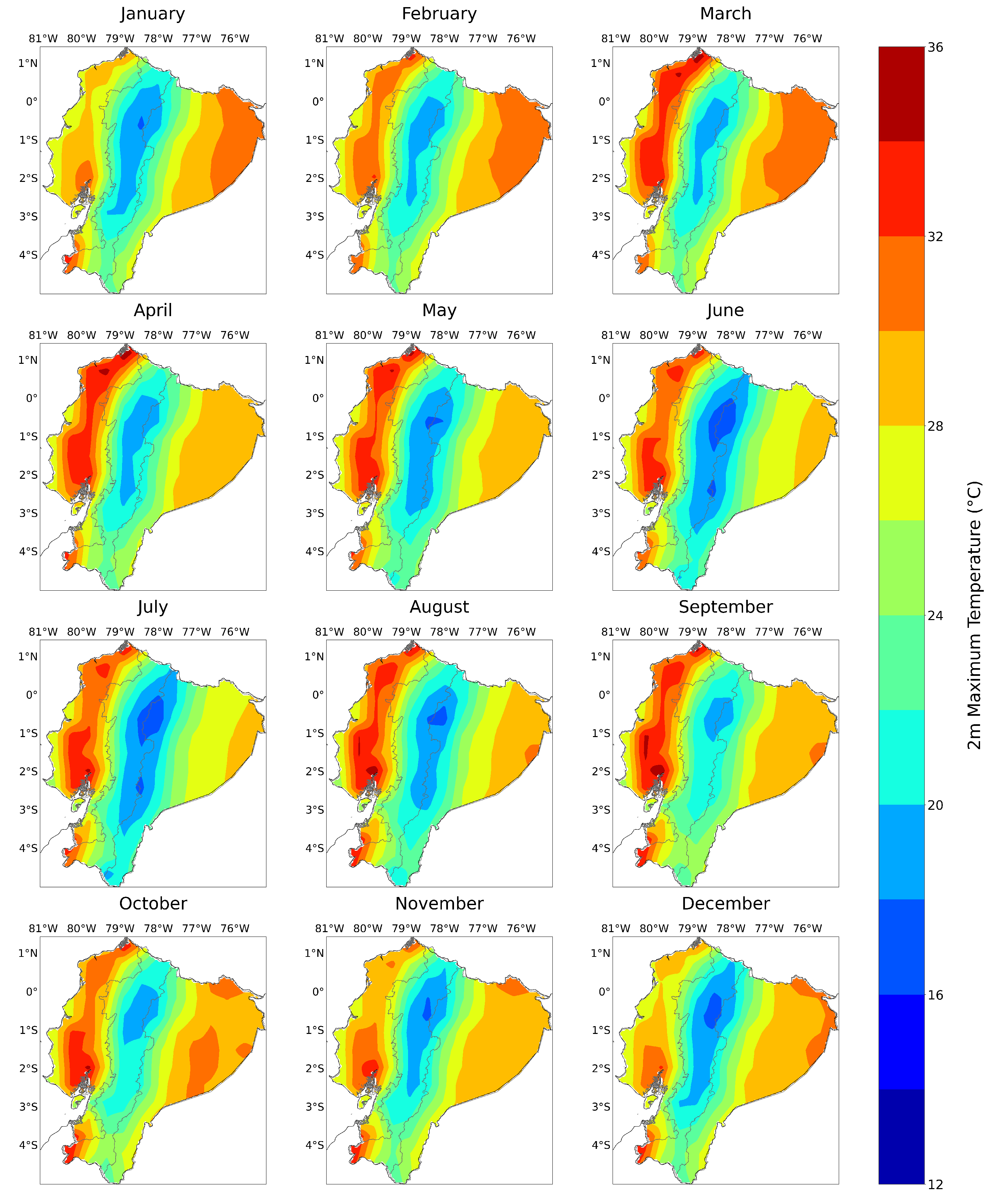
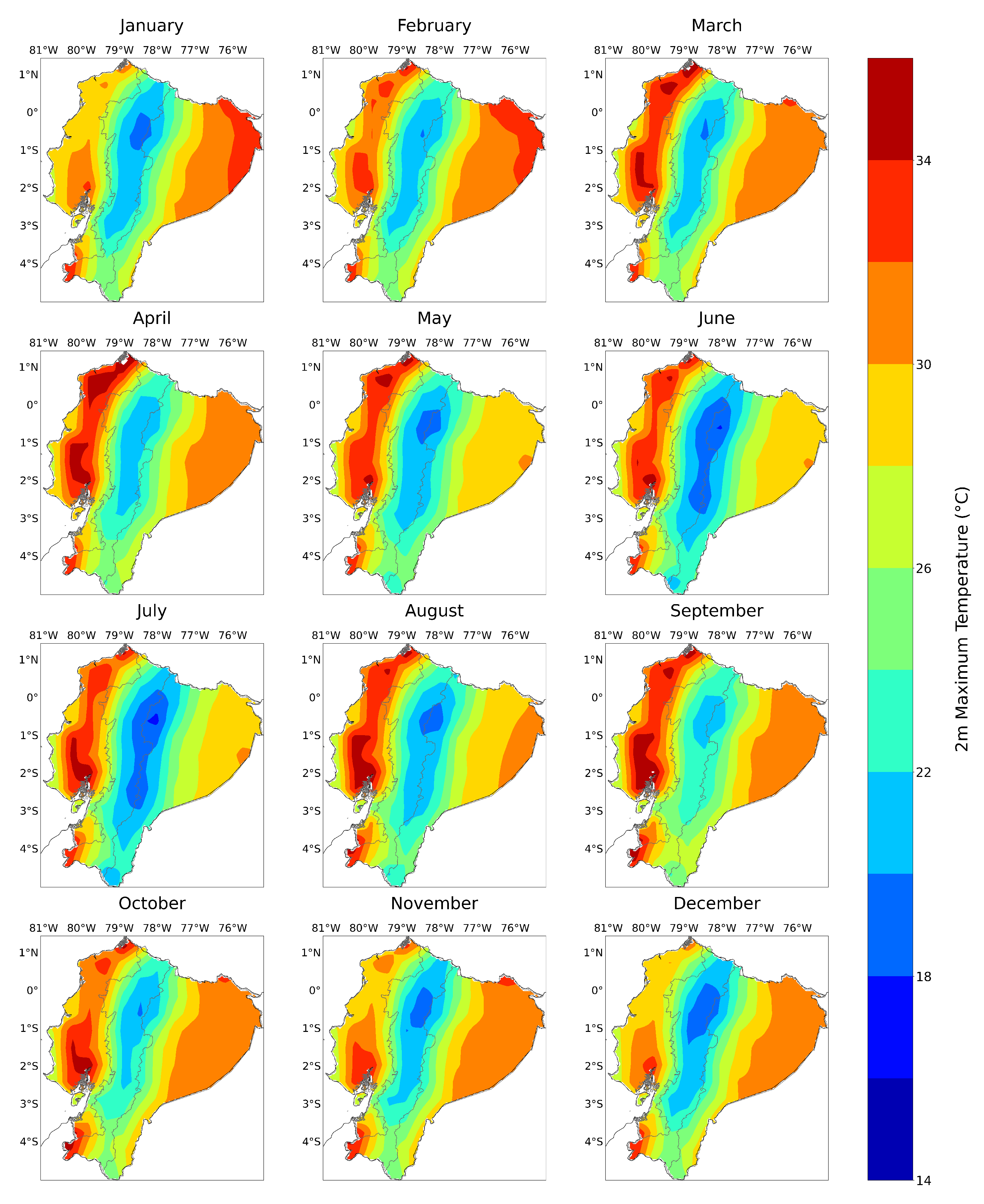
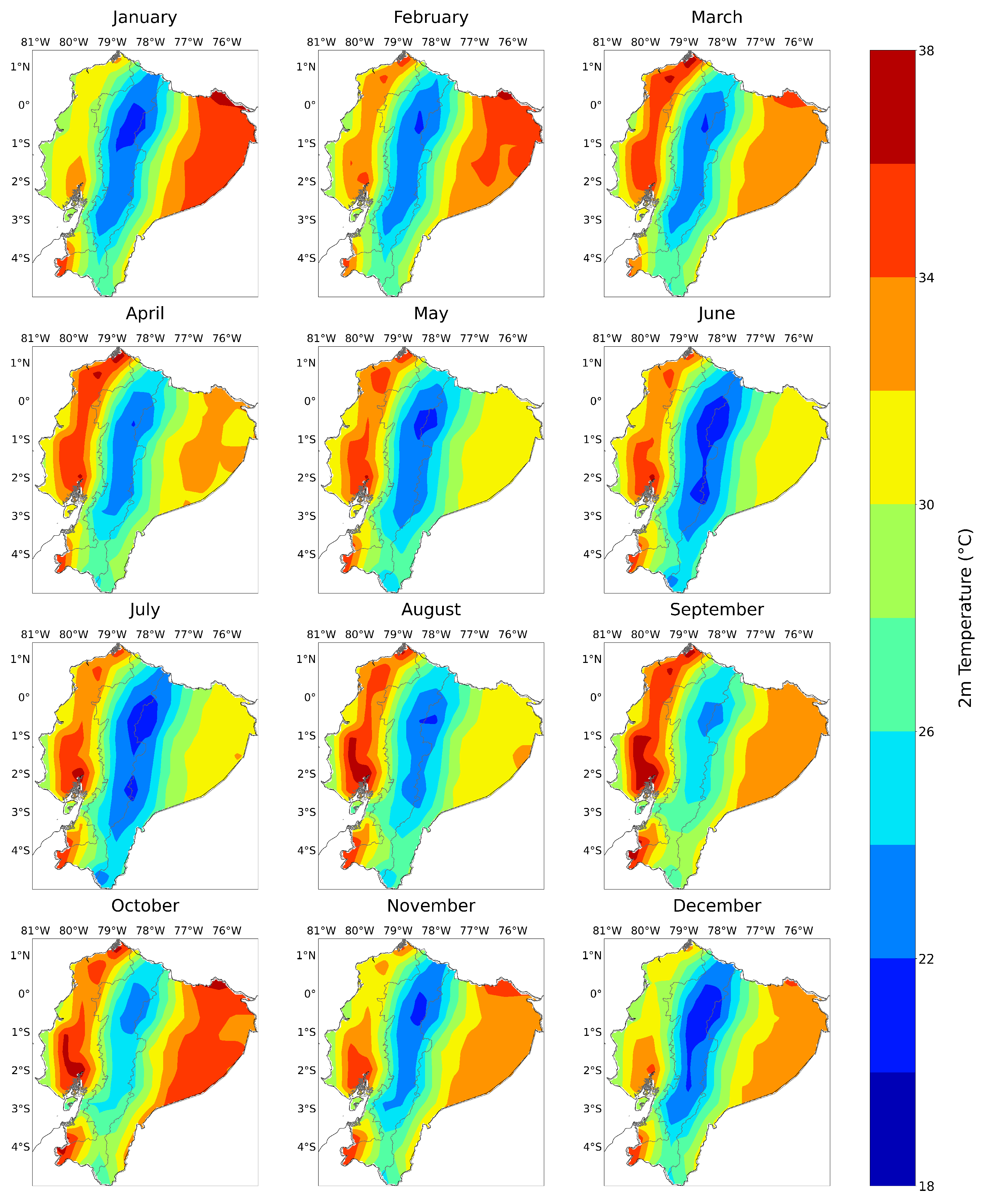
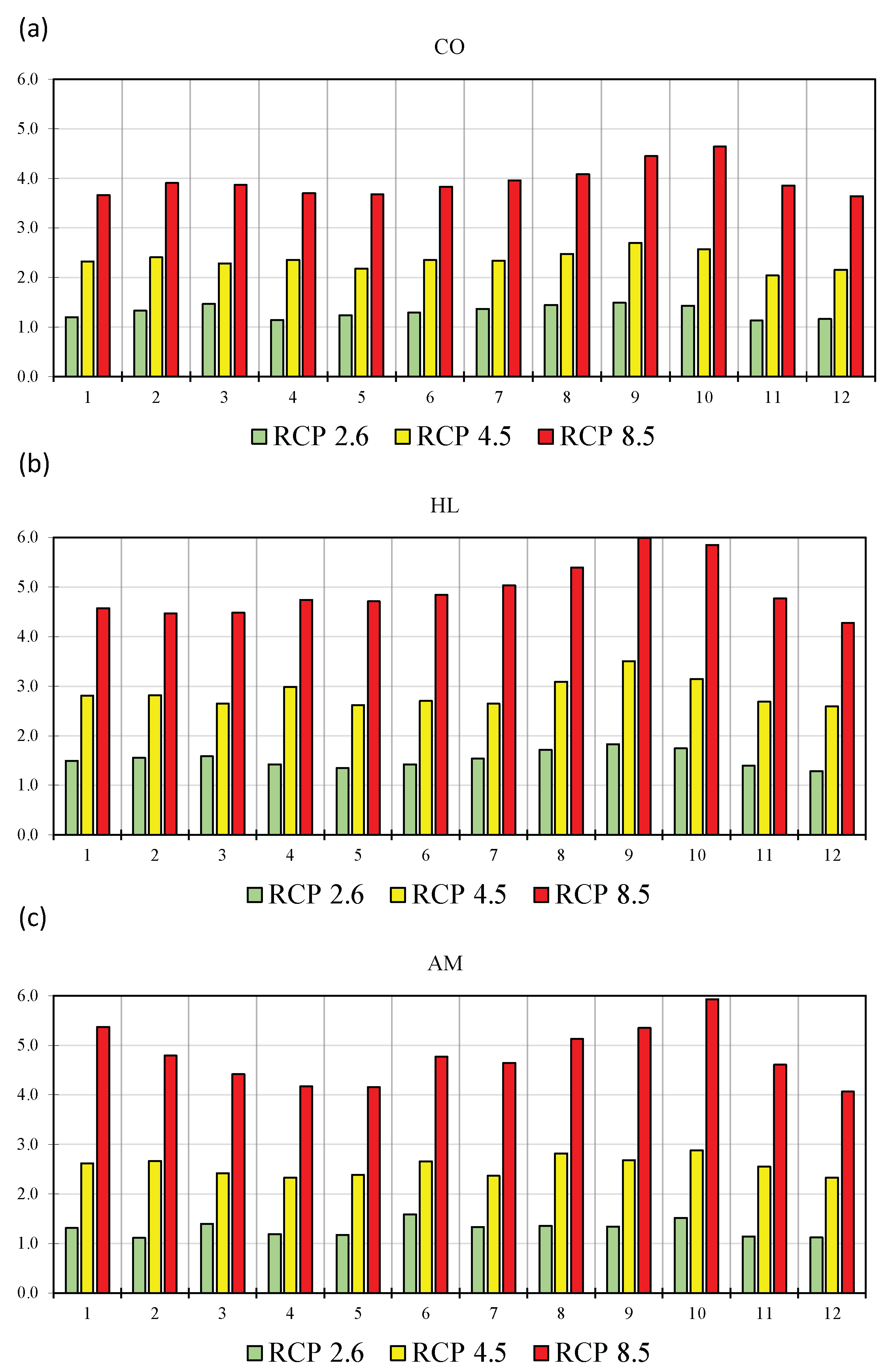
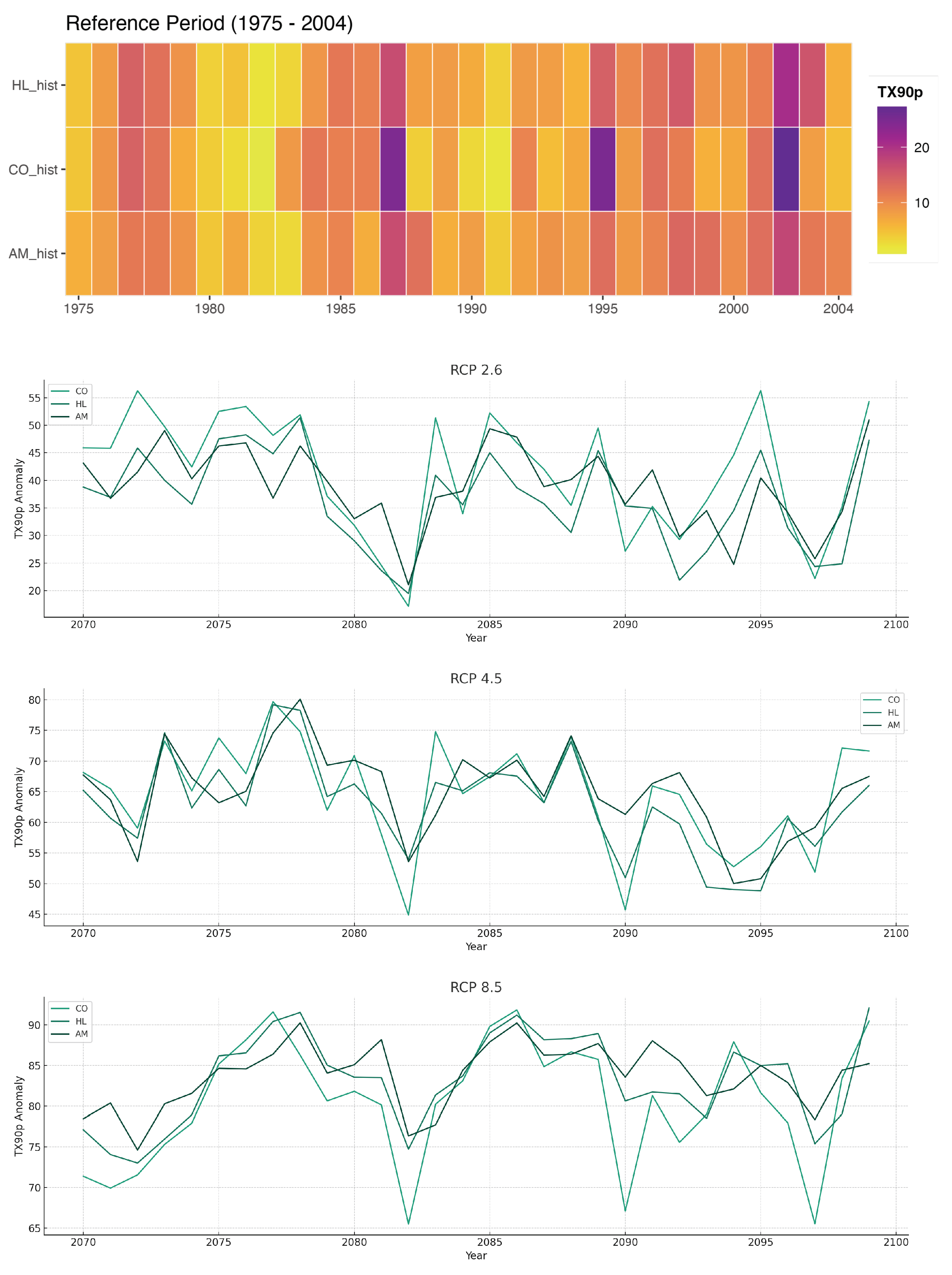

| Parameter | Specification |
|---|---|
| Spatial Grid Resolution | 50 km |
| Geographical Position | Latitude: −1.5, Longitude: −78 |
| Boundary Conditions | Employing relaxation and exponential techniques |
| Cumulus Convection Approach | Based on Emanuel (1991) [27]. |
| Boundary Layer Representation | Following Holtslag et al. (1990) [28]. |
| Moisture Physics | As per Pal et al. (2000) [29]. |
| Initial Simulation Time (Reference Period) | 1975-01-01 00:00:00 UTC |
| Final Simulation Time (Reference Period) | 2005-12-01 00:00:00 UTC |
| Initial Simulation Time (Future Projection) | 2070-01-01 00:00:00 UTC |
| Final Simulation Time (Future Projection) | 2099-11-01 00:00:00 UTC |
| Model Time Step | 30 min |
| COhwfi | HLhwfi | AMhwfi | COtx90p | HLtx90p | AMtx90p | PDO | ONI | |
|---|---|---|---|---|---|---|---|---|
| COhwfi | 1.00 | 0.72 | 0.53 | 0.93 | 0.71 | 0.61 | 0.20 | 0.28 |
| HLhwfi | 0.72 | 1.00 | 0.46 | 0.68 | 0.81 | 0.62 | 0.16 | 0.18 |
| AMhwfi | 0.53 | 0.46 | 1.00 | 0.53 | 0.57 | 0.74 | 0.06 | 0.08 |
| COtx90p | 0.93 | 0.68 | 0.53 | 1.00 | 0.83 | 0.71 | 0.25 | 0.23 |
| HLtx90p | 0.71 | 0.81 | 0.57 | 0.83 | 1.00 | 0.87 | 0.13 | 0.12 |
| AMtx90p | 0.61 | 0.62 | 0.74 | 0.71 | 0.87 | 1.00 | −0.08 | −0.04 |
| PDO | 0.20 | 0.16 | 0.06 | 0.25 | 0.13 | −0.08 | 1.00 | 0.50 |
| ONI | 0.28 | 0.18 | 0.08 | 0.23 | 0.12 | −0.04 | 0.50 | 1.00 |
Disclaimer/Publisher’s Note: The statements, opinions and data contained in all publications are solely those of the individual author(s) and contributor(s) and not of MDPI and/or the editor(s). MDPI and/or the editor(s) disclaim responsibility for any injury to people or property resulting from any ideas, methods, instructions or products referred to in the content. |
© 2024 by the authors. Licensee MDPI, Basel, Switzerland. This article is an open access article distributed under the terms and conditions of the Creative Commons Attribution (CC BY) license (https://creativecommons.org/licenses/by/4.0/).
Share and Cite
Portalanza, D.; Ortega, C.; Garzon, L.; Bello, M.; Zuluaga, C.F.; Bresciani, C.; Durigon, A.; Ferraz, S. Projected Heat Waves in Ecuador under Climate Change: Insights from HadGEM-RegCM4 Coupled Model. Earth 2024, 5, 90-109. https://doi.org/10.3390/earth5010005
Portalanza D, Ortega C, Garzon L, Bello M, Zuluaga CF, Bresciani C, Durigon A, Ferraz S. Projected Heat Waves in Ecuador under Climate Change: Insights from HadGEM-RegCM4 Coupled Model. Earth. 2024; 5(1):90-109. https://doi.org/10.3390/earth5010005
Chicago/Turabian StylePortalanza, Diego, Carlos Ortega, Liliam Garzon, Melissa Bello, Cristian Felipe Zuluaga, Caroline Bresciani, Angelica Durigon, and Simone Ferraz. 2024. "Projected Heat Waves in Ecuador under Climate Change: Insights from HadGEM-RegCM4 Coupled Model" Earth 5, no. 1: 90-109. https://doi.org/10.3390/earth5010005
APA StylePortalanza, D., Ortega, C., Garzon, L., Bello, M., Zuluaga, C. F., Bresciani, C., Durigon, A., & Ferraz, S. (2024). Projected Heat Waves in Ecuador under Climate Change: Insights from HadGEM-RegCM4 Coupled Model. Earth, 5(1), 90-109. https://doi.org/10.3390/earth5010005







